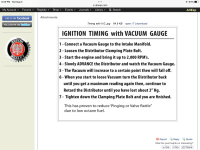Hi guys,
I’m returning to the setting of my 1960 BN7 ignition timing.
I set the static timing and the car runs, but I feel it could be better.
The plug gaps are at .035” and the points gap .015”. I now have the use of a Gunson timing light, but am confused by two of the settings- does the distributor vacuum advance pipe need to be disconnected?
The car was converted to run on unleaded fuel; does this affect the timing light setting?
I’m using an engine idle speed of 800 RPM with the engine at operating temperature.
Any advice would be most welcome, before I dive in and screw things up!
Regards
Dace
I’m returning to the setting of my 1960 BN7 ignition timing.
I set the static timing and the car runs, but I feel it could be better.
The plug gaps are at .035” and the points gap .015”. I now have the use of a Gunson timing light, but am confused by two of the settings- does the distributor vacuum advance pipe need to be disconnected?
The car was converted to run on unleaded fuel; does this affect the timing light setting?
I’m using an engine idle speed of 800 RPM with the engine at operating temperature.
Any advice would be most welcome, before I dive in and screw things up!
Regards
Dace

 Hi Guest!
Hi Guest!

 smilie in place of the real @
smilie in place of the real @
 Pretty Please - add it to our Events forum(s) and add to the calendar! >>
Pretty Please - add it to our Events forum(s) and add to the calendar! >> 


